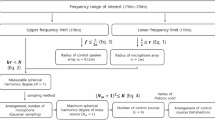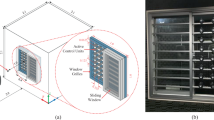Abstract
Noise pollution has become increasingly severe around the world due to fast urbanization. How to soundproof windows from outside noise is of significant interest for both academia and industry. This paper reports an experimental implementation of normalized minmax active noise control (ANC) algorithm on an open window system, where identifying the model of acoustic sound paths plays a central role. By doing this, traffic noise is attenuated by the ANC system, leading to a relatively quiet indoor environment, while the natural lighting and ventilation functions of a window are remained. Our experiments show that an average of 19 dB(A) noise reduction is achieved.







Similar content being viewed by others

References
Begou, P., & Kassomenos, P. (2021). Exposure to the road traffic noise in an urban complex in Greece: the quantification of healthy life years lost due to noise-induced annoyance and noise-induced sleep disturbances. Environmental Science and Pollution Research, 28(10), 12932–12943.
Li, Y., Luo, Z., Xu, Q., & Zheng, W. (2022). A novel narrowband active noise control system with online secondary path modeling based on factor decomposition and application in open space. Applied Sciences, 12(2), 926.
Basner, M., Babisch, W., & Davis, A. (2014). Auditory and non-auditory effects of noise on health. The Lancet, 383(9925), 1325–1332.
Kuo, S. M., & Morgan, D. R. (1996). Active Noise Control Systems: Algorithms and DSP Implementations. New York, NY, USA: Wiley.
Leug, P. (1936). Process of silencing sound oscillations. US Patent 2043416.
Jiang, Y., Chen, S., Gu, F., Meng, H., & Cao, Y. (2021). A modified feedforward hybrid active noise control system for vehicle. Applied Acoustics, 175(6), 107816.
Mazur, K., Wrona, S., & Pawelczyk, M. (2019). Active noise control for a washing machine. Applied Acoustics, 146, 89–95.
Chang, C. Y., Siswanto, A., Ho, C. Y., Yeh, T. K., Chen, Y. R., & Kuo, S. M. (2016). Listening in a noisy environment: Integration of active noise control in audio products. IEEE Consumer Electronics Magazine, 5(4), 34–43.
Hanselka, J., Jukkert S., & Sachau, D. (2016). Experimental study on the influence of the sensor and actuator arrangement on the performance of an active noise blocker for a tilted window, In: Proceedings of the 45th International Congress and Exposition on Noise Control Engineering, pp. 3046–3057. Hamburg, Germany.
Kwon, B., & Park, Y. (2013). Interior noise control with an active window system. Applied Acoustics, 74, 647–652.
Lam, B., Shi, C., Shi, D., & Gan, W.-S. (2018). Active control of sound through full-sized open windows. Building and Environment, 141, 16–27.
Lam, B., Shi, D., Gan, W.-S., Elliott, S. J., & Nishimura, M. (2020). Active noise control broadband sound through the open aperture of a full-size domestic window. Scientific Report, 10, 10021.
Murao, T., Shi, C., Gan, W.-S., & Nishimura, M. (2017). Mixed-error approach for multi-channel active noise control of open windows. Applied Acoustics, 127, 305–315.
Vazquez, A., Maya, X., Fernandez, A., Avalos, G., Sanchez, J., & Perez, H. (2019). FXECLMS algorithm for active acoustic windows: An experimental report. IEEE Latin America Transactions, 17(1), 63–70.
Gonzalez, A., Albiol, A., & Elliott, S. J. (1998). Minimization of the maximum error signal in active control. IEEE Transactions on Speech and Audio Processing, 6(3), 268–281.
Bai, M. R., Pan, W., & Chen, H. (2018). Active feedforward noise control and signal tracking of headsets: Electroacoustic analysis and system implementation. Journal of the Acoustical Society of America, 143(3), 1613–1622.
Tang, Y., Zhang, H., & Zhang, Y. (2023). Stability guaranteed active noise control: Algorithms and applications. IEEE Transactions on Control Systems Technology, 31(4), 1720–1732.
Carter, G. C. (1987). Coherence and time delay estimation. Proceedings of the IEEE, 75(2), 236–255.
Parks, T. W., & McClellan, J. (1972). Chebyshev approximation for nonrecursive digital filters with linear phase. IEEE Transactions on Circuit Theory, 19(2), 189–194.
Nakakuki, T., Shen, T., & Kanae, S. (2022). Special issue on multiagent-based system modeling and control practices. Control Theory and Technology, 18(2), 113.
Author information
Authors and Affiliations
Corresponding author
Rights and permissions
Springer Nature or its licensor (e.g. a society or other partner) holds exclusive rights to this article under a publishing agreement with the author(s) or other rightsholder(s); author self-archiving of the accepted manuscript version of this article is solely governed by the terms of such publishing agreement and applicable law.
About this article
Cite this article
Yuan, Y., Sun, Z. & Zhang, H. Application of system identification in a practical active noise control system. Control Theory Technol. 22, 282–291 (2024). https://doi.org/10.1007/s11768-023-00175-6
Received:
Revised:
Accepted:
Published:
Issue Date:
DOI: https://doi.org/10.1007/s11768-023-00175-6



